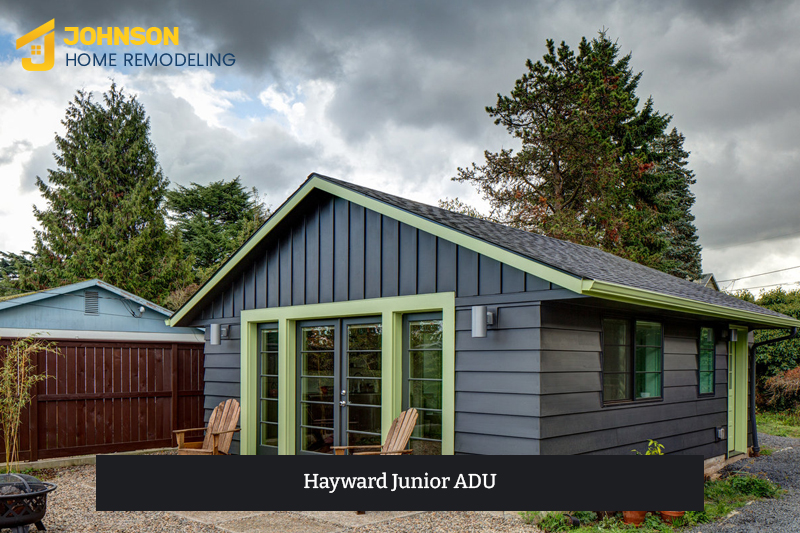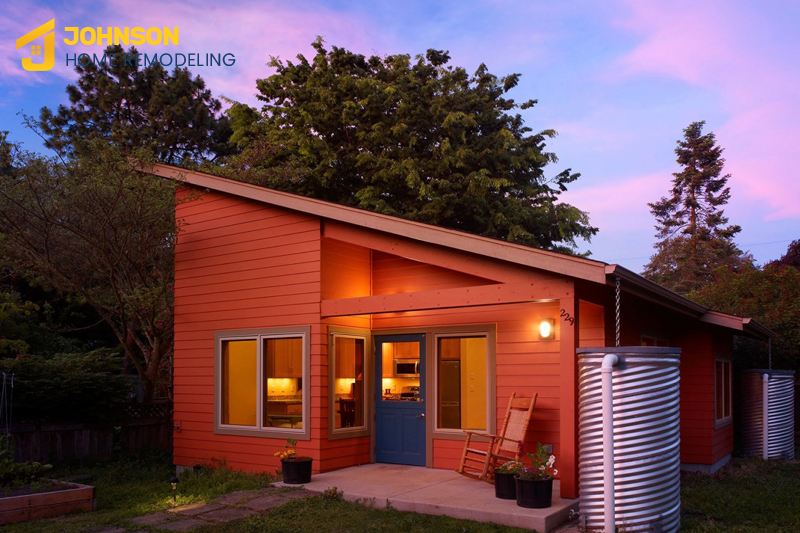Discover the potential of the Hayward Junior ADU as a sustainable solution to the housing crisis. From boosting rental income and reducing carbon footprint to fostering community-building, JADUs transform underutilized spaces into functional homes.
Junior ADU program – affordable housing options in Hayward, California. Semi-independent living spaces within existing homes. Max size: 500 sq ft. There are no reasonable housing fees. Increase rental housing stock: affordable home rental and ownership. The Hayward Housing and Climate Update highlights the importance of safe, affordable, and accessible housing.

A Junior Accessory Dwelling Unit (ADU) is a smaller living space within a single-family or attached guest house. It is designed to provide additional accommodation options and flexibility for homeowners. Also known as an “in-law unit,” “granny flat,” or “second unit,” a junior ADU typically has a maximum size limit of 500 square feet.
It offers a separate entrance, bathroom, and kitchenette, allowing for independent living while connected to the primary residence. This type of dwelling is gaining popularity due to its potential to address housing needs, provide affordable housing options, and promote multigenerational living arrangements.
When constructing your Junior ADU, trust Johnson Home Remodeling – a reliable, experienced contractor that guarantees quality workmanship and satisfaction.
Hayward Junior ADU is an attractive option for homeowners and communities due to its numerous benefits. These units solve the affordable housing crisis by creating additional living spaces within existing homes. Homeowners can generate rental income or accommodate family members while maintaining privacy and independence.
JADUs also contribute to sustainable development by utilizing existing infrastructure and land, minimizing the need for new construction and urban sprawl. They promote multi-generational living and foster community by housing family members or caretakers nearby. Additionally, JADUs have financial benefits for both homeowners and renters. Homeowners can generate supplemental income, while renters enjoy more affordable housing options in desirable neighborhoods.
Regarding flexibility and adaptability, JADUs can be constructed in various sizes, ranging from 150 to 500 square feet, depending on local regulations. They can be designed as standalone structures or integrated into the main house, allowing homeowners to choose the most suitable configuration.
Junior Accessory Dwelling Units offer a practical and sustainable solution to the affordable housing crisis. They provide homeowners with flexibility, financial benefits, and the opportunity to create a more inclusive living environment while addressing environmental concerns and promoting community-based living.
When it comes to building a Junior Accessory Dwelling Unit in Hayward, there are specific permits and regulations that homeowners need to be aware of. These regulations may vary depending on the unit’s location, size, and configuration. It is essential to research and understand these requirements before beginning any construction.
From starting a small business to undertaking construction or remodeling projects. These permits are written authorizations issued by local or federal agencies to ensure compliance with regulations and safety standards. Perm requirements and fees may vary depending on the project and jurisdiction.
While not all projects require permits, it is essential to determine if they are necessary to avoid potential legal issues or penalties. It is advisable to consult with the relevant authorities or seek professional advice to understand the permits required for a particular endeavor.
These regulations ensure that JADUs are safe, habitable, and compliant with the city’s zoning code. JADUs must adhere to specific size and placement requirements, with a maximum size of 800 square feet. They can be attached or detached from a single-family home and must be at least 4 feet from the side and rear property lines and 20 feet from the front property line.
Parking must have at least one space: in the driveway, street, or garage. Adequate parking ensures enough space for residents and minimizes impact on-street parking availability. JADUs must have their own kitchen and bathroom facilities and individual utility connections. This means that each JADU must have its own water and sewer connections and electrical and gas connections. By having separate utilities, JADUs can function independently and provide the necessary amenities for comfortable living.
Homeowners who wish to construct a JADU must obtain a permit from the City of Hayward before starting the construction process. Furthermore, the completed JADU must undergo inspection by the City of Hayward to ensure compliance with building codes and safety regulations. Obtaining permits and undergoing inspections are essential to ensure that JADUs meet all legal requirements and are safe for occupancy.
In addition to the requirements above, there are other regulations that homeowners must observe when building a JADU in Hayward. These include adhering to energy efficiency standards set by the city, meeting fire safety standards, providing accessible entrances and exits, and avoiding excessive noise generation. These additional regulations are in place to ensure that JADUs contribute positively to the community and comply with established guidelines.
When designing an Accessory Dwelling Unit (ADU), consider factors to ensure a well-planned and functional space. Align the size and layout with occupants’ needs and the homeowner’s budget. Optimize available space while prioritizing natural light, ventilation, and energy efficiency.
Ensure accessibility and privacy with features like wide doorways and separate entrances. Harmonize aesthetics with the main house and neighborhood. Plan carefully to align design choices with the budget.
| Design Consideration | Description |
| Size and layout | Consider the needs of the occupants and the budget of the homeowner when determining the size and layout of the ADU. |
| Natural light and ventilation | ADUs should have plenty of natural light and ventilation to create a comfortable and healthy living space. |
| Energy efficiency | ADUs should be designed to be energy-efficient to reduce operating costs. |
| Accessibility | ADUs should be accessible to people of all abilities. |
| Noise reduction | ADUs should be designed to reduce noise transfer between the main house and the ADU. |
| Privacy and security | ADUs should have their private entrance and exit and be secure from unauthorized access. |
| Aesthetics | The ADU should be aesthetically pleasing and complement the main house and the surrounding neighborhood. |
Building a Junior Accessory Dwelling Unit can be affordable and cost-effective to increase housing options. However, it is essential to understand the various costs involved and explore financing options for homeowners.
Building a Hayward Junior ADU can vary based on location, size, configuration, materials, and labor costs. According to a study by UC Berkeley’s Terner Center for Housing Innovation, the average cost of constructing a JADU in California ranges from $50,000 to $75,000. This includes design fees, permits, construction costs, and utility connections.
There are various financing options available for homeowners looking to build a JADU. Options include personal savings or cash-out refinance, where homeowners can use their savings or home equity to fund the construction of a JADU. Homeowners can also take out a traditional loan, such as a home equity line of credit (HELOC) or home equity loan, to finance their JADU project.
Additionally, some cities and states offer government programs that provide financial assistance or incentives for homeowners interested in building a JADU. It is worth researching if any programs are available in your area.
In addition to the traditional financing options mentioned above, homeowners can explore alternative funding sources for building a JADU. These may include crowdfunding, where homeowners can use online platforms to raise funds from friends, family, or the community to finance their JADU project.
Homeowners can also consider loans from family or friends to fund the construction of a JADU. Additionally, some organizations offer grants or scholarship programs for homeowners looking to build an affordable housing unit on their property.

The increasing popularity of Hayward Junior ADU has sparked a discussion about its potential impact on sustainable urban development. By utilizing existing infrastructure and land resources, JADUs can help promote sustainable growth in urban areas.
JADUs allow homeowners to expand their living space and generate rental income. Homeowners can address the affordable housing issue in cities by converting underused areas like basements, garages, or attics into habitable spaces. This innovative solution offers a win-win, maximizing property potential while mitigating the housing crisis.
Strategically using existing structures and promoting infill development, the Joint Accessory Dwelling Unit (JADU) initiative reduces the need for new construction. This approach minimizes urban sprawl and curbs greenhouse gas emissions by repurposing and maximizing existing spaces. JADU aligns with smart growth and environmental conservation principles.
JADU is an ideal housing option for older adults who want to age in place while maintaining independence and staying close to family. These innovative living spaces provide privacy and comfort near loved ones, offering security, convenience, and a harmonious intergenerational living experience.
JADUs foster multi-generational living, strengthening family bonds and promoting neighborhood social interaction. With their functionality and community-building potential, JADUs can transform neighborhoods into thriving, inclusive communities.
If you are considering building a Hayward Junior ADU on your property and exploring financing options, we are here to help. Contact us at (510) 995-0323 to speak to one of our experts, who can guide you through the process and answer any questions. Don’t hesitate to call us today and take the first step towards creating a sustainable, affordable living space.
In conclusion, Junior ADUs offer many benefits to homeowners, including increased housing options, potential rental income, and a model for sustainable urban development. However, it is essential to consider the costs of building a JADU and explore the various financing options available.
With proper planning, Junior ADUs can be a valuable addition to any property and contribute to addressing the affordable housing crisis in our communities. So, if you are a homeowner in Hayward or surrounding areas, do not hesitate to research and consider building a Junior ADU on your property. It could be a win-win situation.